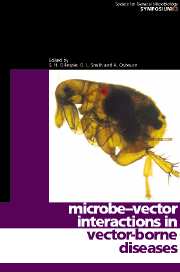Book contents
- Frontmatter
- Contents
- Contributors
- Editors' Preface
- 1 Vector-borne diseases
- 2 Evolution of tick-borne disease systems
- 3 Insect transmission of viruses
- 4 RNA-based immunity in insects
- 5 Specificity of Borrelia–tick vector relationships
- 6 Bunyavirus/mosquito interactions
- 7 How do mosquito vectors live with their viruses?
- 9 Vector competence
- 9 Environmental influences on arbovirus infections and vectors
- 10 Vector immunity
- 11 Transmission of plant viruses by nematodes
- 12 Wolbachia host–symbiont interactions
- 13 Pathogenic strategies of Anaplasma phagocytophilum, a unique bacterium that colonizes neutrophils
- 14 Interactions of Yersinia pestis with its flea vector that lead to the transmission of plague
- 15 Transgenic malaria
- 16 Vaccines targeting vectors
- Index
1 - Vector-borne diseases
Published online by Cambridge University Press: 06 July 2010
- Frontmatter
- Contents
- Contributors
- Editors' Preface
- 1 Vector-borne diseases
- 2 Evolution of tick-borne disease systems
- 3 Insect transmission of viruses
- 4 RNA-based immunity in insects
- 5 Specificity of Borrelia–tick vector relationships
- 6 Bunyavirus/mosquito interactions
- 7 How do mosquito vectors live with their viruses?
- 9 Vector competence
- 9 Environmental influences on arbovirus infections and vectors
- 10 Vector immunity
- 11 Transmission of plant viruses by nematodes
- 12 Wolbachia host–symbiont interactions
- 13 Pathogenic strategies of Anaplasma phagocytophilum, a unique bacterium that colonizes neutrophils
- 14 Interactions of Yersinia pestis with its flea vector that lead to the transmission of plague
- 15 Transgenic malaria
- 16 Vaccines targeting vectors
- Index
Summary
INTRODUCTION
The first discovery of human disease transmission by a vector species was in 1877, when Patrick Manson (who later founded the Royal Society of Tropical Medicine and Hygiene in London) was able to show that transmission of the nematode worms causing lymphatic filariasis involved haematophagous mosquitoes (Manson, 1878). Since that time, hundreds of vector-borne diseases have been described, usually involving arthropod vectors which may transmit not only helminths but also protozoa, bacteria or viruses to cause major epidemics of diseases such as malaria, plague, trypanosomiasis, leishmaniasis, louse-borne typhus, dengue fever, yellow fever, Japanese encephalitis and West Nile fever. The numbers of people who are affected by vector-borne diseases in the world belies the imagination. For example, 750 million people in 76 countries live in areas of endemic filariasis, and an estimated 118 million of them are infected with filariae (World Health Organization, 1995). In India alone, 50000–100000 people die each year from visceral leishmaniasis. Malaria, the most important protozoal disease infecting humans, occurs in areas where Anopheles mosquitoes are present, and causes some 300–500 million clinical cases and approximately 1·2 million deaths worldwide each year. Malaria is the commonest vector-borne disease imported into the USA, and vector-competent Anopheles mosquitoes exist there.
Apart from yellow fever, which can now be controlled effectively by vaccination, most prevention and control programmes have been based on control of the arthropod vector, but a number of factors such as resistance to insecticides and drugs have combined to cause a resurgence of many vector-borne diseases since the 1970s (Gubler, 1998).
This chapter provides an overview of the most important human diseases that are transmitted by an arthropod vector.
- Type
- Chapter
- Information
- Microbe-vector Interactions in Vector-borne Diseases , pp. 1 - 18Publisher: Cambridge University PressPrint publication year: 2004
- 1
- Cited by



